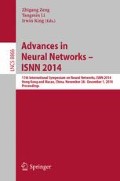Abstract
We present an artificial synaptic plasticity (ASP) mechanism that allows artificial systems to make associations between environmental stimuli and learn new skills at runtime. ASP builds on the classical neural network for simulating associative learning, which is induced through a conditioning-like procedure. Experiments in a simulated mobile robot demonstrate that ASP has successfully generated conditioned responses. The robot has learned during environmental exploration to use sensors added after training, improving its object-avoidance capabilities.
Access this chapter
Tax calculation will be finalised at checkout
Purchases are for personal use only
Preview
Unable to display preview. Download preview PDF.
References
Alnajjar, F., Murase, K.: A Simple Aplysia-Like Spiking Neural Network to Generate Adaptive Behavior in Autonomous Robots. Adaptive Behavior 16(5), 306–324 (2008)
Arkin, R.C., Ali, K., Weitzenfeld, A., Cervantes-Pérez, F.: Behavioral models of the praying mantis as a basis for robotic behavior. Robotics and Autonomous Systems 32(1), 39–60 (2000)
Callan, R.: The Essence of Neural Networks. The Essence of Computing Series. Prentice Hall Europe, London (1999)
Kolb, B., Whishaw, I.Q.: An Introduction to Brain and Behavior, 2nd edn. Worth Publishers, New York (2004)
Likhachev, M., Arkin, R.C.: Robotic Comfort Zones. In: Proceedings of SPIE on Sensor Fusion and Decentralized Control in Robotic Systems III, Boston, vol. 4196, pp. 27–41 (2000)
Michel, O.: Webots: Professional Mobile Robot Simulation. International Journal of Advanced Robotic Systems 1(1), 39–42 (2004)
Neal, M., Timmis, J.: Timidity: A Useful Emotional Mechanism for Robot Control? Informatica 27(2), 197–204 (2003)
Pavlov, I.P.: Conditioned Reflexes: An Investigation of the Physiological Activity of the Cerebral Cortex. Oxford University Press (1927)
Timmis, J., Neal, M., Thorniley, J.: An Adaptive Neuro-Endocrine System for Robotic Systems. In: IEEE Workshop on Robotic Intelligence in Informationally Structured Space, pp. 129–136. IEEE Press, Nashville (2009)
Author information
Authors and Affiliations
Corresponding author
Editor information
Editors and Affiliations
Rights and permissions
Copyright information
© 2014 Springer International Publishing Switzerland
About this paper
Cite this paper
Rizzi Raymundo, C., Johnson, C.G. (2014). An Artificial Synaptic Plasticity Mechanism for Classical Conditioning with Neural Networks. In: Zeng, Z., Li, Y., King, I. (eds) Advances in Neural Networks – ISNN 2014. ISNN 2014. Lecture Notes in Computer Science(), vol 8866. Springer, Cham. https://doi.org/10.1007/978-3-319-12436-0_24
Download citation
DOI: https://doi.org/10.1007/978-3-319-12436-0_24
Published:
Publisher Name: Springer, Cham
Print ISBN: 978-3-319-12435-3
Online ISBN: 978-3-319-12436-0
eBook Packages: Computer ScienceComputer Science (R0)

